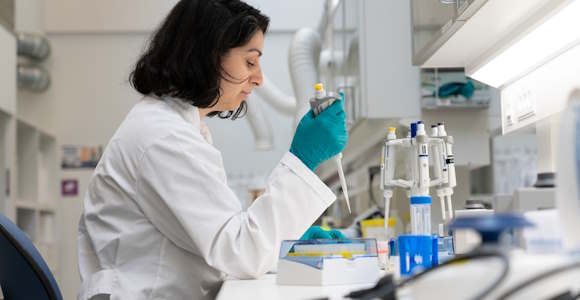
A Passion for Chaotic Proteins
Many serious diseases occur because the body’s proteins malfunction. Neurological disorders, for example, can develop when proteins begin to clump together. Cagla Sahin is fascinated by the steps leading to the formation of these protein clumps — because if we can understand that, we might be able to prevent the diseases altogether.
Proteins are some of the body’s most vital building blocks, controlling nearly all biological processes. Most of them are functional and predictable, doing their job to keep our body running.
But not all proteins are so orderly. Some exist in a more unstable form. They are called intrinsically disordered proteins and they can behave quite chaotically. They are essential for many cellular functions, but they are dynamic and they can shift between different states. In some of these states, they can be harmful. Biophysicist Cagla Sahin is dedicated to studying these disordered proteins:
“They can, for example, clump together. Sometimes that’s a good thing and serves important functions. Other times, it leads to disease. I want to understand how that happens.”
Cancer, virus infections and diabetes
One example of disordered proteins that can cause illness when clumped together is found in the brain tissue of patients with Alzheimer’s — a disease with no known cure.
These clumps occur when two different kinds of proteins build up in and between the brain’s nerve cells. The proteins become toxic and begin killing the cells.
Similar clumping-like behavior is linked to other neurodegenerative diseases like Parkinson’s, ALS, and Huntington’s, as well as various other illnesses, including cancer, viral infections, type 2 diabetes, and corneal dystrophy.

Cagla Sahin
Assistant Professor (tenure track) at the Department of Biochemistry and Molecular Biology, affiliated with the section “Biomedical Mass Spectrometry and Systems Biology.” Cagla holds a PhD in protein biophysics from Aarhus University (2018, under the supervision of Professor Daniel Otzen) and has worked at the Karolinska Institute in Stockholm, supported by the Novo Nordisk Foundation. There, she immersed herself in the technique known as “Native Mass Spectrometry.” Her research focuses on disordered proteins and their formation of protein complexes.
“But there are also natural and functional protein clumps that don’t cause harm,” Sahin says. “They’re involved in, for example, forming long-term memory, spider silk, and even skin pigmentation."
She believes that our scientific curiosity should extend beyond just the disease-causing clumps — we need to look at what happens before the proteins clump.
“If we can get an understanding of those earlier stages, we might be able to prevent the diseases from developing at all.”
According to Sahin, we still don’t know exactly what happens in the brain of an Alzheimer’s patient:
“We actually don’t know whether the initial damage is caused by the protein clumps themselves or by something that happens before the clumping — in another state.”
The chaotic behavior
Her research ambition is to investigate how proteins behave in these other states, which are often fleeting and chaotic.
A single protein might shift between multiple states in milliseconds, the path it takes may not be linear, and there isn’t always a defined end state. In some states, a protein may be harmful. In others, it’s harmless — or even beneficial.
“They can take on many different forms. They’re very dynamic! Sometimes a protein stays in a state for just milliseconds — so it can change constantly,” Sahin explains.
Maybe not troublemakers after all
Naturally, you can’t just stick a microscope into a human body and study protein behavior. Instead, researchers create test-tube environments that mimic the conditions inside our cells. The trick is to make these environments as realistic as possible, so they must include all the different biomolecules that coexist with proteins in our cells.
“My ambition is to recreate such an environment. If I want to study how a specific protein behaves under different influences, I can tag it with fluorescent markers and then observe it under a microscope to see what it does — for example, whether it starts to clump.”
In recent decades, research has shown that our bodies contain surprisingly large numbers of disordered proteins. This has led scientists to challenge the old assumption that disordered proteins are simply cellular troublemakers because they tend to clump. We now know that they play important roles — and we’re beginning to realize that even the clumped states may serve useful functions.
Clumpy long-term memory
“We see so many clumped states but we do not neccesarily know their purpose,” Sahin says.
She points to a recent study that revealed how proteins involved in forming long-term memory are known to form clumps — which then later dissolve.
“That really resembles what we see in neurodegenerative diseases. But in this case, the clumping isn’t harmful — it’s functional. And the clumps dissolve again. So what’s the difference? Why are some clumps harmful and others helpful?”
Once the patient is sick, it can be too late
Cagla Sahin is not alone in being captivated by what happens to disordered proteins in their varying states. Both she and other scientists have shown how disordered proteins can temporarily assemble into droplet-like structures — ones that aren’t necessarily dangerous.
Studying disordered proteins is far from easy. Sahin says:
“These proteins behave so unpredictably, it’s easy to get lost in the chaos. But it’s worth it and it’s important to understand how proteins behave before they clump together and cause disease. Once the patient is sick, it’s too late. If we can understand the process beforehand, we have a better chance of stopping the disease in time.”